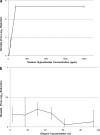Effectiveness of liquid soap and hand sanitizer against Norwalk virus on contaminated hands
- PMID: 19933337
- PMCID: PMC2805232
- DOI: 10.1128/AEM.01729-09
Effectiveness of liquid soap and hand sanitizer against Norwalk virus on contaminated hands
Abstract
Disinfection is an essential measure for interrupting human norovirus (HuNoV) transmission, but it is difficult to evaluate the efficacy of disinfectants due to the absence of a practicable cell culture system for these viruses. The purpose of this study was to screen sodium hypochlorite and ethanol for efficacy against Norwalk virus (NV) and expand the studies to evaluate the efficacy of antibacterial liquid soap and alcohol-based hand sanitizer for the inactivation of NV on human finger pads. Samples were tested by real-time reverse transcription-quantitative PCR (RT-qPCR) both with and without a prior RNase treatment. In suspension assay, sodium hypochlorite concentrations of >or=160 ppm effectively eliminated RT-qPCR detection signal, while ethanol, regardless of concentration, was relatively ineffective, giving at most a 0.5 log(10) reduction in genomic copies of NV cDNA. Using the American Society for Testing and Materials (ASTM) standard finger pad method and a modification thereof (with rubbing), we observed the greatest reduction in genomic copies of NV cDNA with the antibacterial liquid soap treatment (0.67 to 1.20 log(10) reduction) and water rinse only (0.58 to 1.58 log(10) reduction). The alcohol-based hand sanitizer was relatively ineffective, reducing the genomic copies of NV cDNA by only 0.14 to 0.34 log(10) compared to baseline. Although the concentrations of genomic copies of NV cDNA were consistently lower on finger pad eluates pretreated with RNase compared to those without prior RNase treatment, these differences were not statistically significant. Despite the promise of alcohol-based sanitizers for the control of pathogen transmission, they may be relatively ineffective against the HuNoV, reinforcing the need to develop and evaluate new products against this important group of viruses.
Figures


References
Publication types
MeSH terms
Substances
Grants and funding
LinkOut - more resources
Full Text Sources

